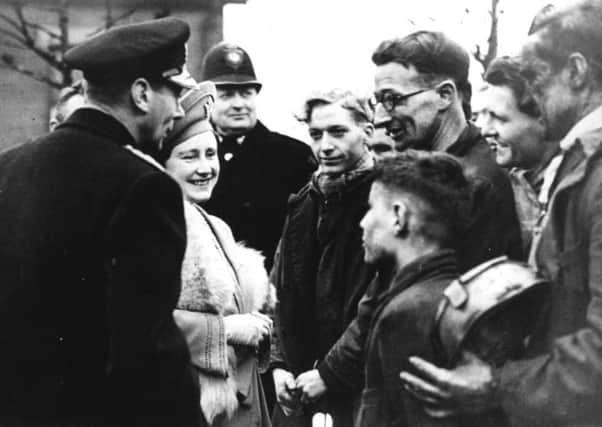Nostalgia on Tuesday: Lifting the spirits


“There’s nothing like the bulldog spirit,” said the Queen during a tour of bombed areas. She was talking to Mr and Mrs Rogan in a rest centre in the city where they, with other bombed-out victims, were enjoying a lunch of sausage, mash and vegetables
“We did not have such a bad time, your Majesty’, said Mr Rogan. ‘The roof was blown in, but we were all right. Hitler can’t frighten us. We’re keeping our peckers up and we’ve got the old bulldog spirit.”
Advertisement
Hide AdAdvertisement
Hide AdThe King and Queen spent three hours touring the bombed areas of the city. They stopped several times and left the car to walk among the ruins and talk to the survivors. At the rest centre, which was one of nine in the city, the King talked to Mr C Cowling, the divisional supervisor, and the Queen told him: “They look so happy and cheerful with it all, it makes a lump rise in one’s throat.”
During the tour there was a visit to a large steelworks, where the King and Queen saw war production in full swing. Hundreds of men and women workers stood round and cheered when, at the end of the factory visit, the King mounted a dais with Allan Grant, the managing director of Thomas Firth & John Brown Ltd. Grant knelt before the King who, taking a sword from his equerry, touched him on both shoulders with it, and said “Arise Sir Allan.” It was the first time a knighthood had been bestowed in public in a factory.
The Royal couple visited Sheffield again on October 29, 1941, when they paid a surprise visit while on their way to Doncaster to see the manufacture of munitions, rolling stock and locomotives in the sprawling local railway works.
On February 9, 1944, they made a six-hour tour of West and South Yorkshire coalfields. They lunched with 70 miners at the canteen at Elsecar Colliery, taking a meal ordinarily served to miners for a shilling. The Queen said they had not had a better meal for a long time. Both King and Queen visited an open cast working at Wentworth and saw giant excavators at work. Other places they visited included Wakefield, Barnsley and Hickleton colliery. At all the centres they chatted with members of the managements and the local production committees and with union leaders.
Advertisement
Hide AdAdvertisement
Hide AdThe Royal couple’s last visit together to Sheffield occurred on September 25, 1945, when they arrived at Sheffield Midland Station on their way to open the Ladybower reservoir. They were met by the Lord Mayor of Sheffield, Coun GE Marlow, who accompanied them.
For part of the journey through the city their car travelled at 5mph to give the public an opportunity to see them. In the days before the event the police had requested that people having no business on the open road to Ladybower reservoir should keep their vehicles off it. King George VI and Queen Elizabeth reached the site around 3pm.
Earlier, on March 17, 1943, the Bishop of Derby, Dr AEJ Rawlinson, had said from the sanctuary of Derwent Parish Church, which was to be demolished under the Ladybower reservoir scheme, that the water supply of great populations was of such vital importance that the church could not resist the submerging of parts of Derwent parish. This included the villages of Ashopton and Derwent. His congregation of villagers, engineers, and hikers filled the pews and stood closely packed at the back as the vicar, the Rev WE Rouse conducted the last evensong in the 81-year-old church. In 1940, bodies from the graveyard had been exhumed and were reburied in the village of Bamford.
All buildings in the village had been demolished by autumn 1943, and the impounded waters of the reservoir began to rise by the end of 1944. The church spire was initially left intact to form a memorial to Derwent.
Advertisement
Hide AdAdvertisement
Hide AdOn the day of Ladybower reservoir’s official opening, the King turned a small wheel which sent water roaring through outlet valves into the weir pool hundreds of feet below, to the cheers of thousands.
The Royal couple walked on to the embankment, where, under a three-ton block of stone suspended from its 103ft derrick, the King deposited a copper cylinder containing silver and copper coins, a booklet about the reservoir and other mementoes. The King and Queen had tea in the Filter House.
The King stopped to chat with Frank Campbell, the only Sheffield stonemason among the workmen at Ladybower. As the mason was telling him how difficult it had been working in the cold weather, the Queen approached and the King, seeing Frank’s box camera, said, ‘Would you like a snap?’ Frank immediately got busy, their Majesties obligingly stepping back slightly at his request so as to be in focus. ‘I hope it will come out all right,’ said the Queen. The Royal couple were then taken to Bamford for their train.
Derwent Valley Water Board’s new reservoir was the largest artificial reservoir, formed by the construction of an earthwork embankment, in Britain.
Advertisement
Hide AdAdvertisement
Hide AdDuring early November 1947, so low was the depth of reservoir water, it was reported that hundreds of people were able to walk on the floor of the former Derwent Church. In December 1947 the church disappeared for good when it was seen as a hazard and demolished. The site of the village has been revealed when the reservoir levels fell again in 1976, 1989, 1996 and 2003.